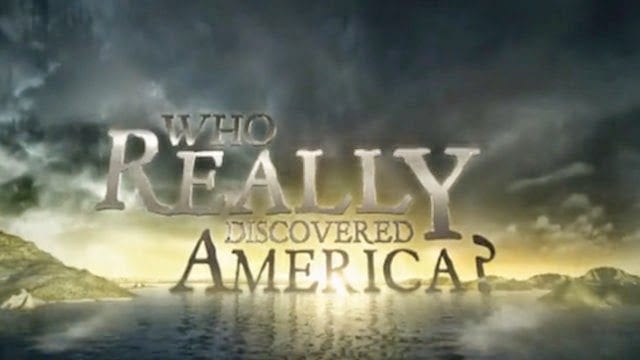
Columbus didn’t really discover America. The western Europeans simply hadn’t heard from the Russians, Chinese and Vikings that it was here. Also, the latter three groups didn’t have the same clout and voter blocks as the Italians and Roman Catholics. So, the half truth is still taught in schools even though we all know it’s not true. So, who really did discover America?
In reality, North and South America were a pristine no-man’s land for thousands of years, literally with ‘no man’ having ever stepped foot in the hemisphere. That all changed around 12,000 BC when humans first stepped onto the North American continent. But who were they? And who else beat Columbus here?
First people in the Americas
It’s widely accepted that approximately 14,000 years ago, humans walked across the Bering Strait from Siberia into Alaska. From there, they spent the next few thousand years slowly migrating south and east across North America, and then into South America. But archeologists have made discoveries that show these early settlers weren’t alone.
At the same time they began leaving behind tools, human bones and other evidence of their presence in the northwest, humans were leaving remarkably similar items along the New England coastline. How was it, historians wondered, that these first inhabitants magically transported themselves so as to start their trek from both Alaska and New England at the same time? The answer – America was discovered simultaneously by two different cultures, one crossing the frozen Bering Strait on foot and the other island-hopping from Europe to America’s east coast by boat.
Biarni Heriulfsson
Fast forward 13,000 years. Around 1,000 AD, the Viking Eric the Red had followed generations-old seafaring routs westward and discovered Greenland. Naming the frozen wasteland ‘green’ land, he hoped to entice and establish Viking settlements, which he did. When Eric the Red’s son Leif Ericsson was old enough to take command over settlements and voyages, he became an influential young man, especially as the son of the man who discovered their new home country.
It was during these days that a young Viking named Bjarni Heriulfsson arrived with his ship in Iceland to sail with his father back to Greenland. When Biarni was told that his father had already set sail, the young son rounded up his crew and set sail as well. History records Biarni Heriulfsson making a foreshadowing statement at that moment, “Our voyage must be regarded as foolhardy, seeing that no one of us has ever been in the Greenland Sea.
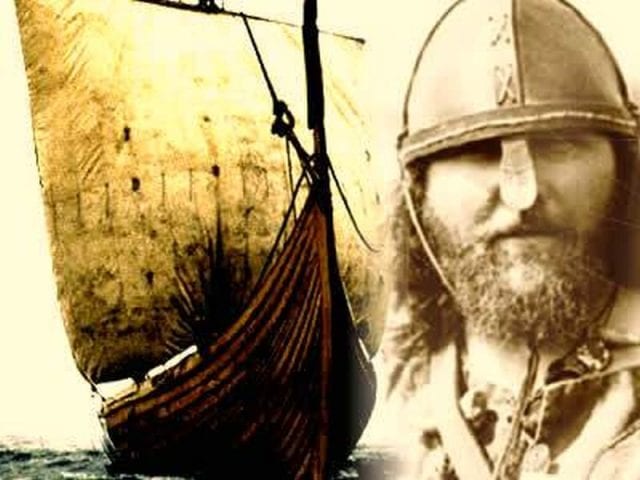
Biarni and his crew eventually made it to Greenland, but not before getting lost in the Atlantic Ocean. The written Norse legends describe a scared and lost crew, adrift in the wide open ocean with no wind and at the tide’s mercy. It eventually pulled them to a chain of islands. When the crew asked if Biarni thought it was finally Greenland, he replied, “no.
He pointed out that each of the islands was covered in grass, hills and woods. He also noticed how there were no rising ice mountains in the background as in Greenland. And most of all, the temperature was nice. When they actually set foot on one of the land masses, they noted how the grass was covered with dew and the Vikings scraped it up with their bare hands. Biarni and his crew eventually found their way back to Greenland where they entertained children and sailors alike with their tale of discovering a new, lush and beautiful land. One of those most fascinated was Leif Ericsson.
Leif Ericsson
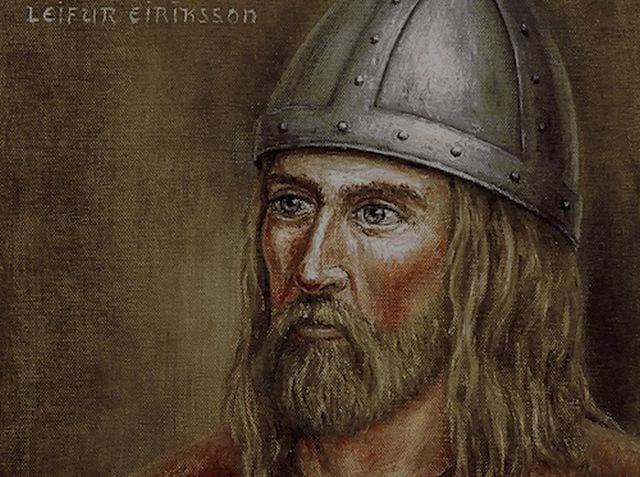
Leif Ericsson was so taken with Biarni Heriulfsson’s tale of accidental discovery, the son of Greenland’s founder went to visit Biarni to inquire further. He ended up buying a ship from him and rounding up a crew of his own. Together with Heriulfsson’s directions and descriptions, Leif Ericsson set sail for this mysterious new world across the Atlantic.
Leif had one ship and a crew of 35, including himself. History records the group as containing 34 Vikings and 1 German. After leaving Greenland, they first happened upon an undiscovered island made of rock with ice mountains in the background. The second island they found contained flat white sand beaches and woodlands. Continuing westward, the third giant island they found may not have been an island at all. Many historians believe that Leif and his crew had just discovered the New England coast.
The Vikings were so happy to find such a beautiful paradise, they built a large cabin and stayed for the winter. They documented an abundance of life-sustaining plant and animal life. In particular, they told of how both the stream and lake were overflowing with the biggest salmon they’d ever seen. Another plentiful item was grapes, which they loaded their ship with for the voyage back to Greenland in the Spring. Upon leaving, they called their newly discovered paradise Vineland, aka America.
The Chinese
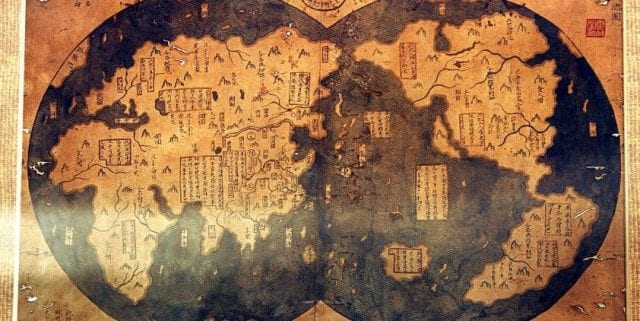
When people argue that the Chinese discovered America in 1421, most cite the book, ‘1421: The Year China Discovered America’ by Gavin Menzies. What the British Menzies did was focus his investigation and theory on a map discovered 30 years earlier in Taiwan by Baptist missionary Dr. Hendon M. Harris. The map turned out to be an ancient relic illustrating the fabled Chinese lost continent of Fu Sang, aka the Americas.
Upon further inspection of the Harris Map, it was determined that the size, location and outline of Fu Sang was almost identical to North America. Taking it as further evidence that Fu Sang is actually North America, the ancient Chinese map also included geographical landmarks, most notably the Grand Canyon. Gavin Menzies believed it was too much of a coincidence and he embarked to discover more evidence that the Chinese had been to America before Columbus and had possibly even maintained regular contact.
For additional evidence, Menzies points to a Chinese relic called the ‘1418 Map’ because that’s the date it’s believe to have been created. The Chinese map includes outlines and details of each of the world’s continents, including North and South America. Even more impressive, it includes accurate depictions of major rivers throughout America. Menzies and many others believe the Chinese couldn’t have mapped inland America without coming here personally.
Columbus and the Native Americans
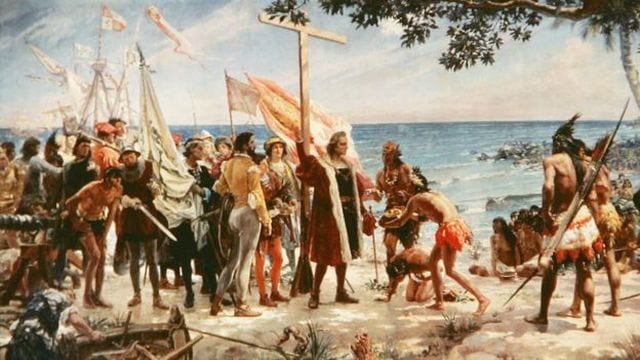
That brings us to 1492 and the year Columbus discovered the Caribbean. Many Native Americans hold Columbus in contempt and mark that year as the date the White man launched his war of genocide upon them. But it’s worth noting that Columbus never made it to America. And Native Americans were immigrants to America themselves at one time, having come from across the oceans. Also just like the white man, the Indian tribes that European settlers wiped out, had wiped out the weaker ethnicities that occupied the lands before them.
Curious one day, this author did a little research on the Indian tribes that occupied our home state of Illinois. Most residents are aware of the Illini Nation and its dominance of the area, mostly because the Fighting Illini is the name of the University of Illinois’ sports teams. But the Illini didn’t peacefully occupy Illinois for thousands of years before Columbus came.
Archeology shows that a smaller, weaker ethnicity of inhabitants occupied the lands of Illinois seemingly since they arrived here in 12,000 BC. In 1500 AD, a violent and powerful new tribe called the Illini appeared and conquered the natives. The Illini held the land until 1700 when the French conquered them. By 1776, it had been conquered by Great Britain. In that year, the land was also invaded and conquered by Virginia. In 1787, Illinois was traded by Virginia to the Northwest Territory. Illinois was then annexed by the Indiana Territory. Finally in 1809, Illinois gained its independence and in 1818 was incorporated as the 21st state in the union.
The moral of the story is that peoples and nations have been getting conquered and annihilated since the beginning of time and they still are today. It doesn’t make it right. It just makes it true. Columbus shouldn’t be vilified for vanquishing the Indians any more than the Indians should be vilified for vanquishing America’s original Asian and European inhabitants who first migrated here 14,000 years ago.





